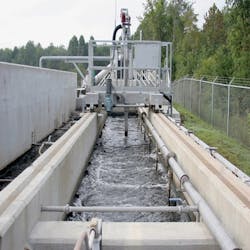Grit & Grease Removal System Uses Parallel Chambers to Treat Water
Schreiber’s grit and grease removal system consists of a rectangular concrete channel with two parallel chambers. The rectangular design provides efficient removal over a wide range of flows.
Flow enters the grit channel, where coarse bubble diffusers located near the bottom create a continuous and adjustable roll in the liquid. The spiral circulation scours, washes and deposits the grit into the bottom trough of the channel. A grit pump mounted to a traveling bridge removes settled grit from the channel and discharges into an elevated grit trough. The grit slurry then flows to a grit classifier for further washing and dewatering before disposal.
[Visit Schreiber's W&WD Storefront]
The grease within the liquid makes contact with air bubbles that provide buoyancy. The divider wall between the grit and grease channels extends slightly below water level. Openings within a baffle system permit the combined air and grease to pass under the wall and float to the surface. The floating grease is continuously transported to the end of the channel by an air/water-skimming system. Air/water lances span the width of the grease channel. Nozzles mounted to each lance direct the air/water to the water surface at an angle, creating a surface current that continuously transports grease to a removal screw.
